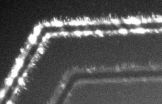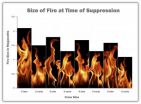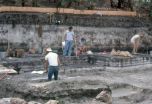(Press-News.org) NASA has chosen the Naval Research Laboratory's (NRL's) Wide-field Imager to be part of the Solar Probe Plus mission slated for launch no later than 2018. The Solar Probe Plus, a small car-sized spacecraft will plunge directly into the sun's atmosphere approximately four million miles from our star's surface. It will explore a region no other spacecraft ever has encountered in an effort to unlock the sun's biggest mysteries.
For decades, scientists have known that the corona, or the outer atmosphere, is several hundreds of times hotter than the visible solar surface and that the solar wind accelerates up to supersonic speeds as it travels through the corona. In the Solar Probe Plus mission, scientists hope to find answers to the questions: why is the solar corona so much hotter than the photosphere? And how is the solar wind accelerated? The answers to these questions can be obtained only through in-situ measurements of the solar wind down in the corona.
NRL's Wide-field Imager for Solar Probe (WISPR) is one of five science investigations selected by NASA for this mission. It is the only optical investigation because the solar environment is so hot the instruments need to be tucked behind a heat shield. NRL's Dr. Russell Howard, the principal investigator, says, "This is an extremely exciting mission - no other spacecraft has ever gone this close - it is like the early voyagers of the earth, we don't really know what to expect, but we know, whatever it is, it is going to be spectacular."
The imager is a telescope, which looks off to the side of the heat shield, and will make 2-D images of the sun's corona as the spacecraft flies through. But like a medical CAT scan, the orbit of the spacecraft through the corona will enable 3-D images and a determination of the 3-D structure of the corona. The experiment actually will see the solar wind and provide 3-D images of clouds and shocks as they approach and pass the spacecraft. "We'll be flying through the structures that we've only seen from 100 million miles away. We'll be able to see all the phenomena (mass ejections, streamers, shocks, comets, and dust) up close. Other instruments will be able to measure the magnetic and electric fields and the plasma itself," explains Howard. This investigation complements instruments on the spacecraft by providing direct measurements of the plasma far away as well as near the spacecraft – the same plasma the other instruments sample.
The other four investigations chosen for the Solar Probe Plus mission include:
The Solar Wind Electrons Alphas and Protons Investigation will specifically count the most abundant particles in the solar wind -- electrons, protons and helium ions -- and measure their properties. The investigation also is designed to catch some of the particles in a special cup for direct analysis. (Smithsonian Astrophysical Observatory in Cambridge, Massachusetts)
The Fields Experiment will make direct measurements of electric and magnetic fields, radio emissions, and shock waves that course through the sun's atmospheric plasma. The experiment also serves as a giant dust detector, registering voltage signatures when specks of space dust hit the spacecraft's antenna. (University of California Space Sciences Laboratory in Berkeley, California)
The Integrated Science Investigation of the Sun consists of two instruments that will take an inventory of elements in the sun's atmosphere using a mass spectrometer to weigh and sort ions in the vicinity of the spacecraft. (Southwest Research Institute in San Antonio, Texas)
The Heliospheric Origins with Solar Probe Plus is led by Dr. Marco Velli who is the mission's observatory scientist, responsible for overseeing assembly of the spacecraft. He will ensure adjacent instruments do not interfere with one another and guide the overall science investigations after the probe enters the sun's atmosphere. (NASA's Jet Propulsion Laboratory in Pasadena, California)
INFORMATION:
The Solar Probe Plus mission is part of NASA's Living with a Star Program. The program is designed to understand aspects of the sun and Earth's space environment that affect life and society. The program is managed by NASA'S Goddard Space Flight Center in Greenbelt, Maryland, with oversight from NASA's Science Mission Directorate's Heliophysics Division. The Johns Hopkins University Applied Physics Laboratory in Laurel, Maryland, is the prime contractor for the spacecraft.
NRL's Wide-Field Imager selected for Solar Probe Plus mission
2010-09-30
ELSE PRESS RELEASES FROM THIS DATE:
New NIST 'standard cigarette' available for fire-resistance testing
2010-09-30
Cigarettes are the most frequent cause of fatalities from residential fires in the United States. So, it might seem surprising to learn that a cigarette that burns stronger than others has been used for decades by manufacturers of home furnishings to test the fire resistance of their products. Making certain that they can continue this life- and property-saving effort is the job of a new standard reference material (SRM) from the National Institute of Standards and Technology (NIST).
NIST SRM 1196, "Standard Cigarette for Ignition Resistance Testing," consists of 10 packs ...
Studies show improved patient tolerance for unsedated colonoscopy using novel water method
2010-09-30
OAK BROOK, Ill. – September 29, 2010 – The October issue of GIE: Gastrointestinal Endoscopy, the monthly peer-reviewed scientific journal of the American Society for Gastrointestinal Endoscopy (ASGE), features the results of two randomized controlled trials of unsedated colonoscopy comparing water infusion versus air insufflation to distend the colon. Both studies showed that patient tolerance with the water method during unsedated colonoscopy was greater than with air insufflation and enhanced patient willingness to undergo a repeat unsedated exam; however, the cecal intubation ...
Growing nanowires horizontally yields new benefit: 'nano-LEDs'
2010-09-30
While refining their novel method for making nanoscale wires, chemists at the National Institute of Standards and Technology (NIST) discovered an unexpected bonus—a new way to create nanowires that produce light similar to that from light-emitting diodes (LEDs). These "nano-LEDs" may one day have their light-emission abilities put to work serving miniature devices such as nanogenerators or lab-on-a-chip systems.
Nanowires typically are "grown" by the controlled deposition of molecules—zinc oxide, for example—from a gas onto a base material, a process called chemical vapor ...
NIST 'Vision Science Facility' aims for lighting revolution
2010-09-30
Light-emitting diodes, or LEDs, have become popular with backpackers and cyclists who mount them on headbands for a reliable, hands-free source of illumination. Now, a new lab at the National Institute of Standards and Technology (NIST) is helping to bring these tiny but brilliant devices into your home, to help save both energy costs and the environment.
"LEDs can be very energy efficient, and they are a lot smaller and last a lot longer than light bulbs," says NIST vision scientist Wendy Davis. "They're what we'll likely use in the future to light our houses and public ...
Children's well-being and varying degrees of family instability
2010-09-30
Bowling Green, OH—September 29, 2010— A forthcoming issue of the Journal of Marriage and Family states that children today are less likely to be born into a "traditional" family structure, defined as two biological married parents. Growing numbers of children in the United States experience multiple family living arrangements during childhood. How these transitions affect the individual child's well-being needs to be fully addressed by researchers and policymakers alike. This article fully reviews the existing research from the past ten years on these topics in an effort ...
NIST residential fire study education kit now available
2010-09-30
Researchers from the National Institute of Standards and Technology (NIST) and the International Association of Fire Fighters have prepared an educational resource for fire chiefs, firefighters, and public officials to summarize and explain the key results of a landmark study on the effect of the size of firefighting crews on the ability of the fire service to protect lives and property in residential fires.
The study, Report on Residential Fireground Field Experiments, was published by NIST last April. The study is the first to quantify the effects of crew sizes and ...
MD Anderson study finds increases in 5-, 10-year survival at every stage of breast cancer
2010-09-30
VIDEO:
This study finds higher survival rate at every stage of breast cancer.
Click here for more information.
HOUSTON - Advances in screening for disease detection, better surgical techniques available to more women, and an increased number of therapies that reduce the risk of relapse in patients with both locally advanced and early stage disease, have collectively contributed to dramatic improvements in breast cancer's survival rates, according to a review of 60 years ...
No evidence for Clovis comet catastrophe, archaeologists say
2010-09-30
New research challenges the controversial theory that an ancient comet impact devastated the Clovis people, one of the earliest known cultures to inhabit North America.
Writing in the October issue of Current Anthropology, archaeologists Vance Holliday (University of Arizona) and David Meltzer (Southern Methodist University) argue that there is nothing in the archaeological record to suggest an abrupt collapse of Clovis populations. "Whether or not the proposed extraterrestrial impact occurred is a matter for empirical testing in the geological record," the researchers ...
A downside to work flexibility?
2010-09-30
TORONTO, ON – Is there a downside to schedule control at work? According to new research out of the University of Toronto, people who have more schedule control at work tend to report more blurring of the boundaries between work and the other parts of their lives, especially family-related roles.
Researchers measured the extent of schedule control and its impact on work-family processes using data from a national survey of more than 1,200 American workers. Sociology professor Scott Schieman (U of T) and PhD student Marisa Young (U of T) asked study participants: "Who ...
In-country OB/GYN training programs contributed to retention of doctors in Ghana, U-M study shows
2010-09-30
ANN ARBOR, Mich. — Ghanaian Obstetrics and Gynecology residents say in-country training programs contributed to their decision to remain in their home country to practice medicine, new University of Michigan research shows.
The retention of trained health care providers in developing countries is a key component to improving health and achieving the United Nations' Millennium Development Goals, which aim to decrease maternal and child mortality. But the migration of health workers from developing to developed countries has resulted in a health care workforce crisis that ...



